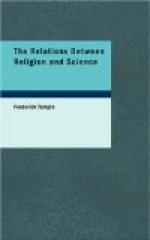the origin and nature of Religion in the second of
these Lectures, it was necessary to follow the order
of thought, and beginning with Duty to end with God.
But the order of fact is not the same. In actual
fact man began with God and ends with a clearer perception
of Duty. Hence in all the earlier stages the morality
is imperfect. The profaneness of Esau is a serious
offence. The ungenerous temper, the unfairness
and duplicity of Jacob are light in comparison.
Truth is not an essential. Blood-shedding and
impurity when in horrible excess are treated as most
grievous sins; but restrained within limits are easily
condoned. Women are placed below their true and
natural place; polygamy if not distinctly allowed
is certainly condoned; divorce is permitted on one
side, not on the other. Slavery is allowed though
put under regulation. But the unity and spirituality
of God are guarded with the strongest sanctions, and
nothing could be said against idolatry and polytheism
now, in sterner and clearer language than was used
then. The reverence for God required then was
as great as the reverence required now. But the
conception of the holiness which is the main object
of that reverence has changed; has in fact been purified
and cleared. And the change is traceable in the
Old Testament. The prophets teach a higher morality
than is found in the earlier books. Cruelty is
condemned as it had not been before. The heathen
are not regarded as outside God’s love, and
the future embraces them in His mercy even if the
present does not. Conscience begins to be recognised
and appealed to. Idolatry is not merely forbidden,
its folly is exposed; it is treated not only with
condemnation, but with scorn. Individual responsibility
is insisted on. Children are not held responsible
for their fathers, though the inheritance of moral
evil and of the consequences of moral evil is never
denied. And even trust in God rises to a higher
level in Habakkuk’s declaration that that trust
shall never be shaken by any calamity that may befall
him, than in the earlier belief that calamities would
never befall those who held fast that trust.
If we review this progress in moral teaching we recognise that it corresponds to the natural and for the most part unconscious working of that instinctive test which, as was pointed out before, we apply to all moral questions, the test of universality. The pivots of all the prophetical teaching are the incessant inculcation of justice and mercy; justice which requires us to recognise the rights of others side by side with our own; mercy which demands our sympathy with the feelings of other creatures that can feel.




